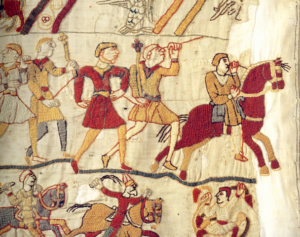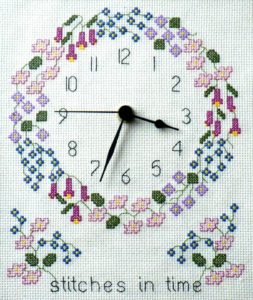There was an excellent attendance and much interest in Denise North’s talk on the role of embroidery in recording history.
Embroidered pictures told a story that could not be shared before the population became literate. Stitching marks our existence onto fabric and also helps us to identify ourselves and our different cultures. A good example of this is the Bayeux tapestry a historical document which is of national and worldwide importance. Apparently it is not a tapestry but an embroidery of wool on linen and it paints picture of life in the 11th Century as well as the battle that led to the demise of an English way of life that was forever lost under the Norman invasion.

Fleeing. Bayeux Tapestry.
Public Domain
Denise showed illustrations and talked us through examples of the different techniques which included cross stitch, counted thread work, ribbon embroidery, straight stitch, stump work and traditional black work. Of course elaborate work was a pastime for women who didn’t have to work, the V & A holds embroideries of Mary Queen of Scots and her ladies, the Bayeux tapestry was made by noble women.
There is an interesting local link to a modern embroidery work by the Quakers, seventy seven panels worked by four thousand men, women and children. One panel depicts Pendle Hill, the site of George Fox’s vision of ‘great people to be gathered’ in 1652. The Quaker movement is said to be dated to that day.
Elizabeth Fry was also a great needlewoman, a little known fact about her life is that she would visit the convict ships before they sailed to Australia and give each woman a bag of ‘useful sewing things’, this meant that the women had something to sell to help them get started in their life when they reached port. Thus demonstrating her forward thinking approach.

Mothers Union Banner, Belaugh, Norfolk. Attribution: Tecoates
World War 1 embroidered silk postcards were intended for the British women, the soldiers from France and Belgium did not do this as their womenfolk already did a lot of embroidery and there was no novelty value in this. A much embroidered flower of course was the Forget – me -not. Another fascinating snippet Denise informed us about was the Signature Cloth which one particular Nursing Home instigated and one which Denise is still researching, trying to tie up the names with present day families and another cloth connected to the WI at Little Marsden.
A contemporary counterpart to the Bayeux tapestry is the Overlord Embroidery. Made after WW2 the embroidery was created between 1968 and 1974 and depicts a reverse invasion from the one 900 years earlier. At 83 metres it took 20 embroiderers and 5 apprentices five years to make. Embroidery is also connected to the German occupation of the Channel Islands where Red Cross parcels helped to reduce starvation levels in the population.

Stitches in time. Credit: Denise North
We were also able to view tapestries of a more personal nature to Denise, memories of holidays in Hawick, Assisi, Cyprus, and Malta among others. The Settle and Carlisle railway was also featured. In some pieces from bought embroidery kits Denise had made her own memorable additions. Other pieces demonstrated embroidered copies of works by Klimt, Picasso, Charles Rennie Mackintosh and a celebration of 200 years of the Leeds and Liverpool Canal.
This was an excellent and enjoyable talk showing also that sewing and embroidery can be a shared experience which is good for the soul which could be said for all shared positive experiences.
Banner Image: A close up of Bayeux Tapestry, Scene 1. Edward the Confessor, Harold 11. Public Domain